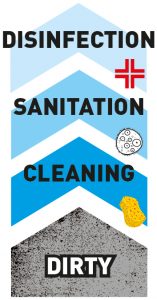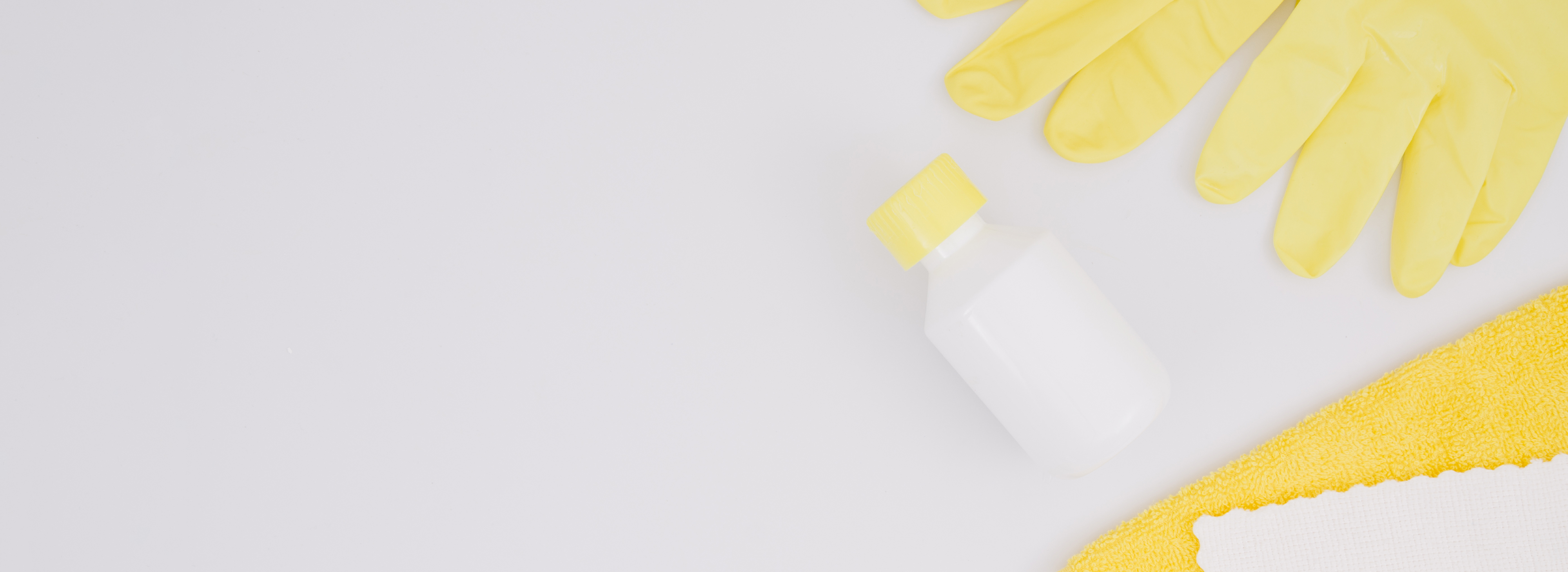Cleaning, hygienization and subsequent disinfection are very sensitive topics nowadays. We are bombarded with indications about the importance of following personal and environmental hygiene regulations. However, these terms are often used as synonyms, creating a lot of confusion in terminology and effective procedures.
The Ministry Circular n. 0005443 of 22 February 2020 issued by the Direzione Generale Prevenzione Sanitaria del Ministero della Salute (Italian Ministry of Health), following suggestions by the WHO (World Health Organisation), gives clear indications on how to carry out the above actions.

Let’s take it one step at a time. First we’ll look at the steps for ideal disinfection:
- Step 1: clean and remove stains from the surface with a cleaner
First, it’s necessary to clean the surface, an action aimed at removing superficial dirt, such as dust, organic dirt, stains, etc. It is a fundamental phase because stains and dirt are the ideal habitat for the proliferation of germs and bacteria.
- Step 2: sanitise the surface with a sanitiser
Sanitising means to make a surface hygienic, in other words, eliminate germs and bacteria from an object or surface.
- Step 3: disinfect with a government-certified disinfectant
The term disinfection is often confused with hygienisation, but they actually have very different meanings. A disinfectant is formulated to drastically diminish the presence of bacteria, fungus and/or virus (by 99.9%), and it is subject to compliance with the requirements set out in the “Rules Governing Medicinal Products in the European Union”.
It’s useless to disinfect a dirty surface!
Sanitising and/or disinfecting surfaces without previously cleaning them to remove accumulated dirt can end up being insufficient. Deep set dirt, if not completely removed, becomes a receptacle for germs and bacteria that will start proliferating soon after disinfection.
Indications from the Ministry of Health regarding effective cleaning and sanitation
The Ministry of Health indicates as effective and sufficient in “non-healthcare settings (homes, public buildings, schools, etc.) the careful cleaning of surfaces with water and appropriate cleaners” such as CLEANER PRO and PS87 PRO to eliminate accumulated dirt before the decontamination phase.
“For decontamination, we recommend the use of sodium hypochlorite at 1% after cleaning. For surfaces which could be damaged by sodium hypochlorite, use ethanol at 70% after cleaning with a neutral cleaner.” FILA’s neutral cleaners which may be used for this purpose are CLEANER PRO and BRIO.
“Surfaces which are frequently touched should be cleaned with particular attention, including walls, doors, widows, bathrooms and toilets.” Cleaners from FILA’s product range that fill this requirement are BRIO and VIA BAGNO. If necessary, proceed with disinfection as previously described.
In conclusion, the first step is always cleaning surfaces by removing all dirt residue before proceeding with disinfection.
The right product for every surface
CLEANING PORCELAIN AND CERAMIC TILE
In order to remove accumulated dirt on surfaces in porcelain and ceramic tile we recommend using effective cleaners such as PS87 PRO for organic dirt or DETERDEK PRO for inorganic dirt. When necessary, proceed with disinfection as previously stated.
CLEANING MARBLE, STONE AND WOOD
For delicate surfaces like marble, natural stone and agglomerates, wood, waxed surfaces, etc., we recommend using CLEANER PRO or BRIO, cleaners with a neutral pH that do not damage surfaces and do not leave residue. When necessary, proceed with disinfection as previously stated.
Caution!! DISINFECTANTS containing sodium hypochlorite (bleach) or ethanol (ethyl alcohol) may irreparably stain and damage delicate surfaces.
After cleaning, protect surfaces with an anti-stain sealer
It’s fundamentally important to protect absorbent surfaces with anti-stain sealers (water and oil repellents) to block dirt from penetrating and staining the material.
FILA has a complete range of sealers designed to satisfy the needs of different surface types, such as grout, natural stone, agglomerates and other absorbent materials.
Search FILA products to protect your surfaces.

2 Replies to “Procedures of cleaning, hygienization and disinfection of home surfaces”
Thank you for sharing. Disinfection and sterilization – are they the same thing? Deep disinfection can be equated with sterilization?
Regards,
Joseph
Good morning Joe,
I give you a general description of the difference of the 2 terms you can easily find on the web: Disinfection and sterilization are both decontamination processes.
But while disinfection is the process of eliminating or reducing harmful microorganisms from inanimate objects and surfaces, sterilization is the process of killing all microorganisms.
We remain at your disposal for any further information you may need.
Best Regards,
Chiara